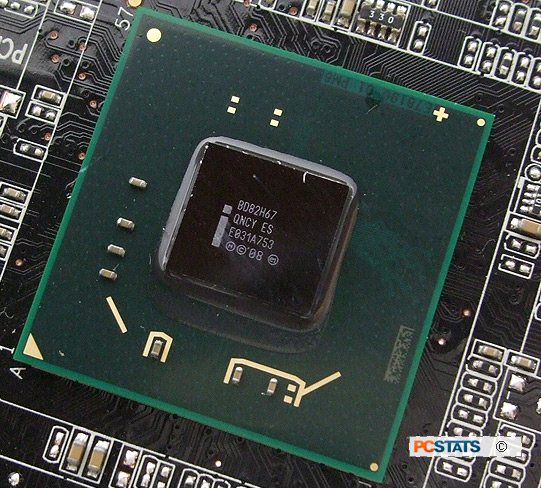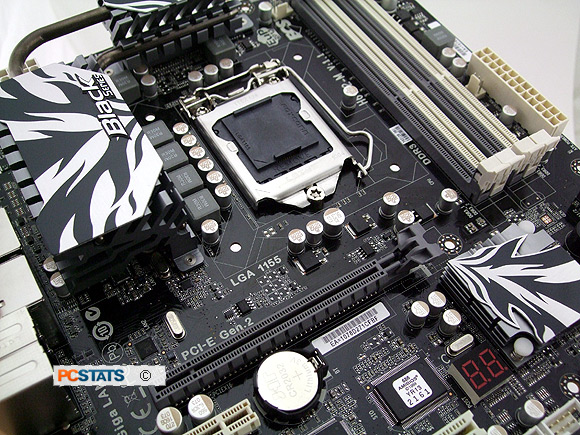 The Intel H67
Platform Controller Hub communicates with socket
1155 'Sandy Bridge' processors over a 20Gb/s DMI link, it contains eight PCI Express 2.0
lanes while the remaining 16-lanes come from the processor itself. Although the Intel
H67 and P67 chipsets are very similar feature wise, the chipsets
differ in regards to integrated graphics support. The Intel
H67 includes Intel's Flexible Display Interface (FDI) so it can output video, the Intel
P67 does not.
The Intel H67
Platform Controller Hub communicates with socket
1155 'Sandy Bridge' processors over a 20Gb/s DMI link, it contains eight PCI Express 2.0
lanes while the remaining 16-lanes come from the processor itself. Although the Intel
H67 and P67 chipsets are very similar feature wise, the chipsets
differ in regards to integrated graphics support. The Intel
H67 includes Intel's Flexible Display Interface (FDI) so it can output video, the Intel
P67 does not.
Intel's FDI can be thought of as a
direct line to the integrated graphics core built into every Sandy Bridge
microprocessor. An FDI link allows users to unlock Sandy Bridge's integrated graphics core and use
it for everyday work, for tasks like hardware-based video transcoding acceleration via Intel Quick
Sync, or light gaming.

With the Intel H67 users have access to H.264 &
MPEG2 encode and
support for HDMI 1.4 with 3D. Standard features brought forth by the Intel H67 / HD 3000 combo
include a 4th generation Unified Shader Architecture, H.264, VC-1 and MPEG-2
hardware decoding, 12 Execution Units, Open
GL 3.0, Shader Model 4.1 and DirectX 10.1
support.
Lack of DX11 support obviously limits the Intel H67
/ HD 3000 IGP's usefulness in the FPS gaming arena, but by that
same measure, IGPs aren't meant for intensive FPS gaming. The Intel HD 3000 IGP supports
HDMI 1.4 which provides support for Stereo 3D and delivers uncompressed
HD video and uncompressed multi-channel audio in a single cable, supporting 720p, 1080i and 1080p formats.
Intel Chipset Feature
Breakdown
The Intel H67, P67 and Z68 chipsets are closely
related, however the newer Intel Z68 chipset includes tweaking features of the P67
and tools like Intel SRT which PCSTATS has extensively dicussed in
here and also here (worth the read!). The chipset feature breakdown
chart helps understand the minor differences between each of the three 6-series core logic.
| Intel Chipset Feature
Comparison |
|
Intel Z68
Express |
Intel P67
Express |
Intel H67 Express |
| CPU |
LGA 1155
Core i5/i7 2nd Gen. |
LGA 1155
Core i5/i7 2nd Gen. |
LGA 1155
Core i5/i7 2nd Gen. |
| Chipset Code Name |
Couger Point (65nm) |
Couger Point (65nm) |
Couger Point (65nm) |
| Bus Interface / Speed |
DMI 20Gb/s |
DMI 20Gb/s |
DMI 20Gb/s |
| Memory Support |
DDR3-1333, dual channel |
DDR3-1333, dual channel |
DDR3-1333, dual channel |
| Maximum Memory Capacity |
32GB (64-bit) |
32GB (64-bit) |
32GB (64-bit) |
| Integrated Graphics |
Yes. via CPU |
- |
Yes. via CPU |
| Integrated Graphics Ports |
HDMI, DVI, DP, VGA |
- |
HDMI, DVI, DP, VGA |
| PCI Express 2.0 Lanes |
8 |
8 |
8 |
| PCI Express x1 Lanes |
0 |
0 |
0 |
| Intel Rapid Storage Technology |
Yes |
Yes |
Yes |
| Intel Smart Response Technology |
Yes |
- |
- |
| SATA 6Gb/s | SATA 3Gb/s | IDE Ports |
2/4/0 |
2/4/0 |
2/4/0 |
| RAID |
0, 1, 5, 10 |
0, 1, 5, 10 |
0, 1, 5, 10 |
| Intelgrated LAN |
10/100/1000 MAC |
10/100/1000 MAC |
10/100/1000 MAC |
| USB 3.0 Ports |
0 |
0 |
0 |
| USB 2.0 Ports |
14 |
14 |
14 |
| PCI Masters |
0 |
0 |
0 |
| Intel High Definition
Audio |
Yes |
Yes |
Yes | | |
QuickSync - Video Transcoding
Acceleration
Quick Sync is Intel's name
for a hardware based video transcoding acceleration technology. Here's what it
can do - In the PCSTATS labs we set about to convert a 450MB 1080i high
definition MPEG2 video via Cyberlink MediaShow Espresso 6 to a 640x360 MP4 video
format suitable for the iPhone
4.
| Video Transcoding Test |
|
Without Intel
QuickSync |
With Intel
QuickSync |
|
Intel Core i5 2500K /
ECS H67H2-M |
48
sec |
14
sec | |
Using an Intel Core i5 2500K / nVidia Geforce GTX470
/ ECS H67H2-M test system, this video transcoded in ~48 seconds. Not a
bad length of time, but with the videocard removed and Quick Sync enabled via
the Intel HD3000 integrated graphics core things go even faster. The same
450MB video transcods in ~ 14 seconds with Intel Quick Sync
enabled.
|

Socket LGA1155 for
Intel 2nd-Generation Core i3/i5/i7 2xxx-series
processors.
|
To use Intel QuickSync you need to plug your display into
the motherboard's video ports and run off the Intel HD3000/2000 integrated graphics
core. Pretty simple.
